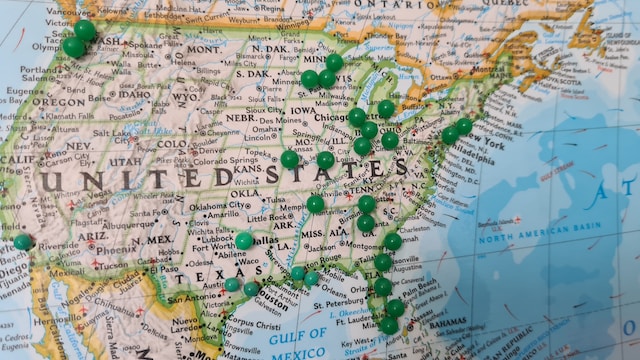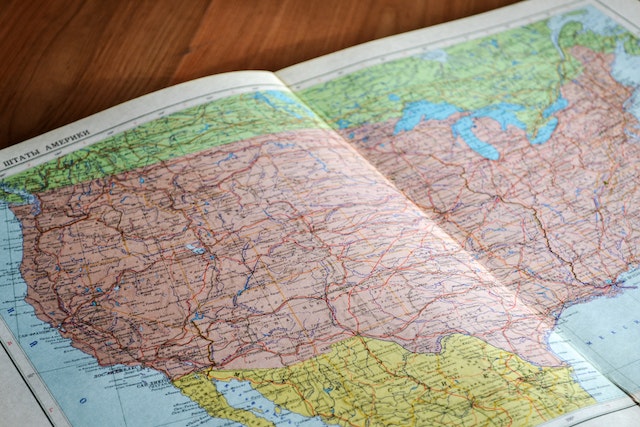Indeed, the journey of a thousand miles begins with a step. The westward expansion map visually represents a significant era in America’s history. In this westward expansion era, courageous pioneers embarked on a perilous journey to settle in the vast lands of the western United States.
The journey came with challenges, as these pioneers had to transverse treacherous terrains and iconic trails to dwell on the fertile lands. This guide provides beneficial insights on the map of westward expansion. It also uncovers an iconic trail, the Oregon Trail, which holds prominence in America’s history. First, let’s discover the motive behind the westward expansion map—Manifest Destiny.

- How Manifest Destiny Helps Unveil the Westward Expansion Map
- Key Elements of the Westward Expansion Map
- 5 Impacts of the Manifest Destiny Map in The United States of America
- An Overview of the Iconic Oregon Trail Map With Landmarks
- Simple Steps To Creating a Labeled Westward Expansion Map
- You Can Create Historical And Modern Interactive Maps With Mapize
How Manifest Destiny Helps Unveil the Westward Expansion Map
In understanding how the westward expansion map came about, we must consider a peculiar belief that drove early pioneers of the 19th century. Manifest Destiny is a concept deeply rooted in the American psyche at the time. It was a general belief that it was the United States’ destiny to expand its territory from the Atlantic to the Pacific Ocean.
This ideology, fueled by a sense of divine mission and American exceptionalism, provided the moral justification for the westward expansion. Thus, the westward expansion was the physical realization of Manifest Destiny. It encompassed the migration, settlements, and acquisition of new territories by Americans as they moved westward in pursuit of land, resources, and opportunity.
The search for new markets and the desire to spread American values and institutions fueled the westward expansion. Thus, the westward expansion map is a visual aid that illustrates the United States’ territorial growth progression due to Manifest Destiny.

Key Elements of the Westward Expansion Map
The westward expansion stands as a testament to the pioneering spirit and resilience of the American people. It helped transform the United States into a vast nation with big cities and states, connecting the Atlantic and Pacific coasts.
The westward expansion map has fascinating features showing how these intrepid pioneers expanded their territories to the western lands.
The Westward Expansion Map Features Iconic Trails and Routes
The westward expansion map features the prominent trails and routes that facilitated the westward migration of early pioneers in North America. They include:
- Oregon Trail: The iconic Oregon Trail spans approximately 2,000 miles from Missouri to the fertile lands of the Pacific Northwest, specifically Oregon.
- California Trail: The California trail, stretching over 2,000 miles, connected Missouri to the gold fields of California. During the westward expansion era, it attracted thousands of fortune seekers during the California Gold Rush.
- Santa Fe Trail: The Santa Fe Trail, extending from Missouri to Santa Fe in present-day New Mexico, served as a vital trade route between the United States and Mexico.
Key Land and Territory Acquisitions Are Features of the Westward Expansion Map
The westward expansion map highlights the territories acquired by the United States through various means, including purchases, treaties, and conquests. Some of the key acquisitions include:
- Louisiana Purchase: The Louisiana Purchase, acquired from France in 1803, doubled the size of the United States. It extended its territory from the Mississippi River to the Rocky Mountains.
- Florida Acquisition: Through the Adams-Onís Treaty of 1819, the United States obtained Florida from Spain, solidifying its control over the southeastern region.
- Texas Annexation: Texas declared independence from Mexico and joined the United States as a new state in 1845. This led to the Mexican-American War.
- Oregon Territory: Through diplomatic negotiations with Great Britain, the United States secured control over the Oregon Territory. It also encompasses present-day Oregon, Washington, and parts of Idaho and Wyoming.
- Mexican Cession: Due to the Mexican-American War (1846-1848), the United States acquired vast territories. This includes California, Nevada, Utah, Arizona, New Mexico, and parts of Colorado and Wyoming.

Landmarks and Settlements Are Important Features on the Westward Expansion Map
The westward expansion map showcases significant landmarks and settlements that emerged along the westward journey. These landmarks became vital waypoints or resting places for the pioneers. Some include:
- Independence Rock: In present-day Wyoming, Independence Rock was a landmark along the Oregon Trail and an important gathering point for travelers.
- Chimney Rock: Rising over 300 feet above the plains of Nebraska, Chimney Rock served as a prominent landmark on the Oregon Trail, guiding pioneers westward.
- Fort Laramie: Originally a fur trading post, Fort Laramie in present-day Wyoming became a crucial stop along various trails. It also became a supply route, resting stop, and traveler protection.
The Westward Expansion Map Showcases Indigenous Nations
The westward expansion map acknowledges the presence of indigenous nations that inhabited the lands during the westward movement. It highlights Native American territories and tribal boundaries, recognizing the impact of westward expansion on indigenous communities.

5 Impacts of the Manifest Destiny Map in The United States of America
The Manifest Destiny map illuminates the Westward expansion era’s profound impact and lasting legacy in American history through its actualization. Let’s consider some of them below:
- Territorial Growth: The westward expansion map showcases the extent to which the United States expanded its boundaries. It reflects the acquisition of vast territories, which doubled the nation’s size and established a continuous presence from the Atlantic to the Pacific Ocean.
- Conflict and Consequences: The westward expansion had challenges and conflicts. As settlers moved westward, tensions with indigenous nations escalated. This resulted in displacement, violence, and the erosion of Native American sovereignty. Moreover, the expansion of slavery and the question of its extension into newly acquired territories further intensified sectional divisions. Ultimately, it led to the American civil war.
- Economic Transformation: The westward expansion brought about significant economic changes. The acquisition of new territories opened vast agricultural, mining, and commerce lands. The California Gold Rush, for example, spurred economic growth and attracted immigrants from around the world, contributing to the nation’s development.
- Cultural and Social Dynamics: The westward expansion influenced the development of a distinct American identity and fostered a spirit of individualism, self-reliance, and perseverance. It also led to cultural exchanges, as settlers encountered diverse communities, including Native Americans, Mexicans, and other European immigrants.
An Overview of the Iconic Oregon Trail Map With Landmarks
The Oregon Trail is special in the annals of American history and westward expansion map. Stretching over 2,000 miles, this trail served as a gateway to the fertile lands of Oregon. The Oregon Trail map with landmarks is a testament to the perseverance and resilience of these settlers.
The journey on the Oregon Trail began in Independence, Missouri. It meandered through the rugged landscapes of Kansas, Nebraska, Wyoming, and Idaho and finally reached Oregon. Along this route, pioneers encountered several notable landmarks that provided hope, relief, and challenges in their quest for a new beginning.
Notably, these landmarks have become part of the westward expansion map, so let’s consider some of them below:
- Independence Rock: Situated in present-day Wyoming, Independence Rock held great significance for pioneers as it marked the beginning of their journey. It provided a sense of reassurance and symbolized progress as pioneers etched their names upon it.
- Chimney Rock: Rising majestically in present-day Nebraska, Chimney Rock served as a guiding landmark for pioneers. Its distinctive shape made it easily identifiable and a beacon of hope on their journey.
- Fort Laramie: Located in Wyoming, Fort Laramie served as a vital resupply point and a resting place for weary travelers. It offered a much-needed opportunity for pioneers to replenish their supplies and gather their strength before pressing on.
- South Pass: Nestled in the Rocky Mountains, South Pass was a pivotal point for pioneers. Its relatively gentle slopes provided a passage through the formidable mountains on their westward journey.
- Snake River: Cutting through Idaho, the Snake River presented both an obstacle and an opportunity for pioneers. Its treacherous currents and steep banks challenged their progress. Still, it also offered a vital water source during the arduous journey.

Simple Steps To Creating a Labeled Westward Expansion Map
This guide has provided insights into the westward expansion map. However, we must accurately capture this remarkable period’s essence to create a detailed and labeled westward expansion map. Consequently, here’s a step-by-step guide to creating a westward expansion map with labels:
Step 1: Research and Gather Information
Begin by extensively researching the Westward Expansion era, focusing on prominent trails like the Oregon Trail, California Trail, and Santa Fe Trail. Study historical maps, diaries, and pioneers’ accounts to understand the geographical features, landmarks, and routes.
Step 2: Select a Suitable Base Map
Choose a base map that accurately represents the Western United States during the westward expansion era. Ensure it includes relevant details such as rivers, mountain ranges, and prominent cities.
Step 3: Identify and Mark The Trails
Using the gathered research, mark the routes of key trails on the base map. Highlight the Oregon Trail, California Trail, and Santa Fe Trail, along with their starting and ending points.
Step 4: Add Significant Landmarks
Incorporate the significant landmarks along each trail onto the map. Include Independence Rock, Chimney Rock, Fort Laramie, South Pass, Snake River, and other notable points of interest.
Step 5: Provide Labels and Descriptions
Label each trail clearly, using appropriate fonts and colors to distinguish them. Label the landmarks and provide concise descriptions to give readers a deeper understanding of their historical significance.
Step 6: Add Visual Elements
Enhance the map’s visual appeal by including illustrations or icons representing wagons, settlers, Native American territories, and other relevant elements. This will evoke the spirit of the westward expansion era.
Step 7: Review and Refine
Ensure accuracy and consistency by reviewing the map thoroughly. Check for errors and adjust to create a polished and professional final product.
You Can Create Historical And Modern Interactive Maps With Mapize
With all its thrilling details and historical significance, the westward expansion map is a powerful testament to early pioneers’ courage and determination. It further revealed their ambitions in forging a path across the American frontier.
It is a reminder of the transformative power of exploration and the human spirit’s capacity for resilience and adaptation. Just as the westward expansion map unveils a captivating story of the United’s State growth, Mapize, a mapping platform, allows us to create dynamic and interactive maps. Thanks to the platform’s advanced mapping AI technology, these maps can tell stories of adventure, discovery, and progress.
Furthermore, with Mapize, you can explore and map your journeys and leave a digital legacy for generations to come. Also, you can map multiple locations for future trips on this mapping platform. Thus, get onboard with Mapize today and create your first custom maps for free.






